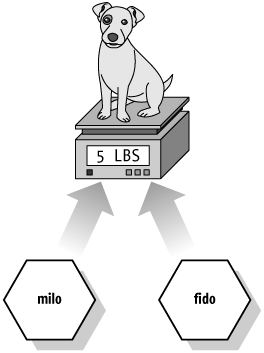18.4. The Heap
| The heap is an undifferentiated block of memory; an area of RAM in which your objects are created. When you declare an object (e.g., milo) you are actually declaring a reference to an object that will be located on the heap. A reference is a variable that refers to another object. The reference acts like an alias for the object. When you allocate memory on the heap with the New operator, what you get back is a reference to the new object: Dim milo As New Dog( ) Your new Dog object is on the heap. The reference milo refers to that object. The reference milo acts as an alias for that unnamed object, and you can treat milo as if it were the Dog object. You can have more than one reference to the same object. This difference between creating value types and reference types is illustrated in Example 18-1. The complete analysis follows the output. Example 18-1. Heap versus stack Module Module1 Public Class Dog Public weight As Integer End Class Public Sub Main( ) ' create an integer Dim firstInt As Integer = 5 ' create a second integer Dim secondInt As Integer = firstInt ' display the two integers Console.WriteLine( _ "firstInt: {0} second Integer: {1}", firstInt, secondInt) ' modify the second integer secondInt = 7 ' display the two integers Console.WriteLine( _ "firstInt: {0} second Integer: {1}", firstInt, secondInt) ' create a dog Dim milo As New Dog( ) ' assign a value to weight milo.weight = 5 ' create a second reference to the dog Dim fido As Dog = milo ' display their values Console.WriteLine( _ "Milo: {0}, fido: {1}", milo.weight, fido.weight) ' assign a new weight to the second reference fido.weight = 7 ' display the two values Console.WriteLine( _ "Milo: {0}, fido: {1}", milo.weight, fido.weight) End Sub End Module Output: firstInt: 5 second Integer: 5 firstInt: 5 second Integer: 7 Milo: 5, fido: 5 Milo: 7, fido: 7 Main begins by creating an integer, firstInt, and initializing it with the value 5. The second integer, secondInt, is then created and initialized with the value in firstInt. Their values are displayed. firstInt: 5 second Integer: 5 Because Integer is a value type, a copy of the value is made, and secondInt is an independent second variable, as illustrated in Figure 18-1. Figure 18-1. A copy of firstInt When you assign a new value to secondInt: secondInt = 7 the first variable is unaffected. Only the copy is changed, as illustrated in Figure 18-2. Figure 18-2. Only the copy is changed The values are displayed and they are now different: firstInt: 5 second Integer: 7 Your next step is to create a simple Dog class with only one member: a Public variable weight.
You instantiate a Dog, and save a reference to that Dog in the reference milo: Dim milo As New Dog( ) You assign the value 5 to milo's weight field: milo.weight = 5 You commonly say that you've set milo's weight to 5, but actually you've set the weight of the unnamed object on the heap to which milo refers, as shown in Figure 18-3. Figure 18-3. milo is a reference You next create a new reference to Dog (fido) and initialize it by setting it equal to milo. This creates a new reference to the same object on the heap. Dim fido As Dog = milo Notice that this is syntactically similar to creating a second Integer variable and initializing it with an existing Integer, as you did before: Dim secondInt As Integer = firstInt Dim fido As Dog = milo The difference is that Dog is a reference type, so fido is not a copy of milo, it is a copy of the reference. Thus, fido is a second reference to the same object to which milo refers. That is, you now have an object on the heap with two references to it, as illustrated in Figure 18-4. When you change the weight of that object through the fido reference, you are changing the weight of the same object to which milo refers. This is reflected in the output: milo: 7, fido: 7 It isn't that fido is changing milo, it is that fido is changing the same (unnamed) object on the heap to which milo refers. Figure 18-4. fido is also a reference |
EAN: 2147483647
Pages: 162
- Chapter IV How Consumers Think About Interactive Aspects of Web Advertising
- Chapter XIII Shopping Agent Web Sites: A Comparative Shopping Environment
- Chapter XV Customer Trust in Online Commerce
- Chapter XVI Turning Web Surfers into Loyal Customers: Cognitive Lock-In Through Interface Design and Web Site Usability
- Chapter XVII Internet Markets and E-Loyalty
